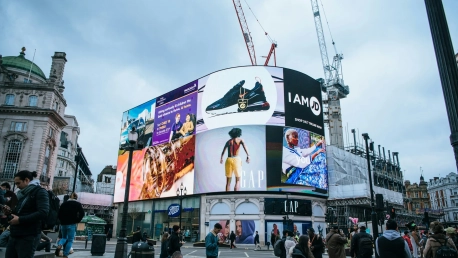The rise of social media has revolutionized advertising, blending the digital world with physical marketing channels such as outdoor advertising. In this dynamic environment, each medium can enhance the other, creating a powerful synergy that magnifies the impact of marketing campaigns.As we examine the fusion of online and offline advertising, we uncover opportunities to maximize the benefits of both. Social media platforms can extend the reach and influence of outdoor ads, while these tangible displays can add a sense of permanence and real-world connection to digital campaigns.Furthermore, the data and targeting capabilities of online platforms can inform the placement and content of outdoor advertising, making it more relevant and effective. Conversely, the visibility of outdoor advertisements can drive online conversations and engagement, making them a valuable component of an integrated marketing strategy.This interplay between digital and physical marketing not only broadens the audience for campaigns but also offers multiple touchpoints for consumer engagement. Such a strategy enables brands to tell a cohesive story across varied channels, potentially leading to a more impactful and memorable advertising experience.As the advertising realm continues to evolve, the combination of social media’s vast reach and the tangible presence of outdoor ads is proving to be a dynamic duo that can greatly enhance traditional marketing efforts.
The Symbiotic Relationship Between Outdoor Ads and Social Media
The Evolution of Outdoor Advertising
Outdoor advertising, with its deep historical roots, has always been a canvas for innovation and public engagement. From the early painted signs to the gargantuan digital billboards of today, this medium has continually adapted to the society it serves. The infusion of digital methods has granted these once-static images a dynamic new lease on life. Interactive screens and intelligent systems now tailor content in real-time, using data to enhance relevance and impact. Through technological advancements, these traditional banners have transformed into responsive, engaging platforms that command the attention of passersby in our fast-paced world.Key to this transformation is the strategic incorporation of digital technology. The juxtaposition of high-res screens, real-time content updates, and context-aware systems signifies a paradigm shift. These enhancements enable advertisers to engage with audiences more effectively, transforming outdoor ads from mere visual stimuli into gateways for interaction and digital exploration.
The Integration of Social Media
Social media’s rise has created an unprecedented amplifying effect on outdoor advertising. Platforms like Twitter, Instagram, and Facebook have transformed the visibility and engagement of outdoor ads, providing a digital echo that extends far beyond their physical location. Savvy marketers now integrate social media calls-to-action directly within the ad’s design, prompting viewers to share their experiences online. This interactivity not only garners additional audience engagement but also breeds a virality that can significantly widen an ad campaign’s reach.Case studies reveal the potency of this strategy; for instance, campaigns that encourage selfies or hashtags connected to the ad material often see a ripple effect online. Such social sharing becomes a form of endorsement, with each post contributing to the ad’s overall impact, fostering a sense of community and shared experience around the brand’s message.
Strategic Placement and Design for Maximum Engagement
Choosing High-Impact Locations
The crux of maximizing an outdoor ad’s effectiveness lies in its placement. A high-impact location is not chosen by mere visual prominence alone, but through a sophisticated analysis of demographic data and foot traffic patterns. By understanding the audience, their behaviors, and transit routes, advertisers can strategically site their installations where they are most likely to engage the target demographic. This data-driven approach ensures that advertisements do not exist in isolation but are instead poised precisely where the likelihood of audience engagement peaks.The technological strides in data analysis tools have become the fulcrum for such strategies. Geographic information systems (GIS) and mobility tracking offer deep insights into the very movements and habits of potential consumers, crafting a map of opportunity for outdoor advertising placements.
Designing with Social Sharing in Mind
Designing outdoor ads today necessitates a nod to the shareable nature of content. Advertisers must craft visuals and messages that not only catch the eye but also inspire passersby to reach for their phones. Elements that tend to encourage sharing include striking visuals, clever wordplay, or interactive components, which can turn a simple billboard into a social media sensation. Moreover, ads that are designed to be photogenic or contain elements of surprise tempt audiences to share their experience, granting the ad a digital life.By incorporating social-centric design principles such as aesthetically pleasing visuals or incorporating elements that are trending in digital culture, ads can resonate more effectively with an audience that is ever-ready to engage via their smartphones, capturing the moment in a shared community space online.
Leveraging User-Generated Content for Authenticity
Encouraging Audience Interaction
Engagement is the currency of modern advertising, and there is no form richer than user-generated content. Encouraging the audience to interact with an outdoor ad—be it through a creative hashtag, an immersive experience, or a call to create user-driven media—can yield profound benefits. These interactive campaigns serve as a bridge, not only between the advertisement and the consumer but also between physical and digital realms. User interaction results in content that is perceived as more authentic and trustworthy than traditional corporate messaging, which is highly valued by contemporary audiences.Interactive outdoor ads should offer simple yet attractive provocations for engagement, prompting users to become brand ambassadors through their creative expressions. When individuals contribute content, their networks take notice, exponentially increasing the advertisement’s reach and influence.









